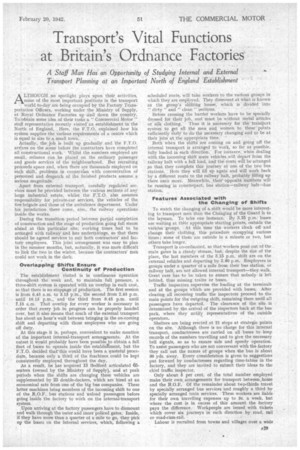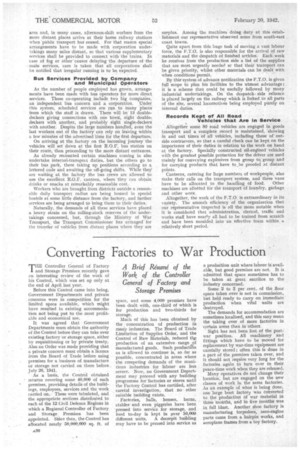Transport's Vital Functions at Britain's Ordnance Factories
Page 31

Page 32

If you've noticed an error in this article please click here to report it so we can fix it.
A Staff Man Has an Opportunity of Studying Internal and External Transport Planning at an Important North of England 'Establishment ALTHOUGH no spotlight plays upon their activities, some of the most important positions in the transport world to-day are being occupied by the Factory Transportation Officers, working under the Ministry of Supply, at Royal Ordnance Factories up .dad down the country. To 'obtain soine idea of their tasks a "Commercial Motor " staff representative recently visitedan establishment -in the North of England. Here, the F.T.O. explained how his system supplies the various requirements of a centre which is equal in size to a small town. , ; • ,
Actually, the job is built up gradually and the F.T.O. arrives on the scene before the contractors have completed all constructional work. Whilst the numbers ernployed are
.small, reliance can be placed on the ordinary passenger
and goods services of the neighbourhood. But recruiting proceeds apace and, when the are thousands employed on each shift, problems in connection with concentration of personnel and despatch of the finished products assume a serious magnitude. .
• Apart from external transport, Carefully regulated services must be provided between the various sections of any large industrial estate, whilst the F.T.O. also assumes responsibility for private-car services, the vehicles of the firesbrigade and those of the ambulance department. Under his jurisdiction there come, also, the railway operations inside the works: . During the transition period between partial completion of construction and the stage of production going full steam ahead at this particular site, working times had to be arranged with railway and bus undertakings, so that there should be agreed services to suit both contractors' and fac tory emplbyees. This joint arrangement was easy to plan in the summer months, but, naturally, it was more difficult to link the two in the winter, because the contractors' men could not work in the dark.
Overlapping Shifts Ensure Continuity of Production The establishment visited is in continuous operation throughout the week and, to maintain full pressure, a three-shift system is operated with an overlap in each case, so that there is no stoppage of production. The first session is from 6.95 a.m. to 3.15 p.m., the second from 2.95 p.m. until 10.15 p.m., and the third from 9.45 p.m. until 7.15 a.m. That overlap for every worker is necessary in Order that ,every job in progress can be properly handed over, but it also means that much of the external transport has about an hour's wait between bringing in the on-coming shift and departing with those employees who are going off duty.
At this stage it is, perhaps, convenient to make mention of the important internal-transport arrangvments. At the outset it would probably have been possible to obtain a full fleet of buses to operate inside the establistment, but the F.T.O. decided that' this would have been a wasteful procedure, because only a thisd of the machines could be kept consistently employed throughout the day. As a result, he has acquired 13 Bedford articulated (15seaters (owned by the Ministry of Supply), and at peak periods when the shifts are changing these vehicles are supplemented by 23 double-deckers, which are hired at an economical rate from one of the big bus companies. These latter machines bring members of the incoming shift to one of the R.O.F. bus stations and unload passengers before going inside the factory to work on the internal-transport system Upon arriving at the factory passengers have to dismount and walk through the outer and inner policed gates. Inside,. if they have more than a quarter of a mile to go, they pick up the buses on the internal services, which, following a scheduled route, will take workers to the various groups in which they are employed. They dismount at what is known as the group's shifting house, which is divided into ". dirty" and " clean " sections : • Before crossing the barrier workers have to be specially dressed for their job, and 'must be without metal articles
or silk clothing. Thus it is necessary for the transport system to get all the men and women to these-points sufficiently earlY to do the necessary changing' and to be at their 'jobs at.the appropriate time.'. — • Both 'when the shifts' are coming on and going off the internal transport is arranged to work, so far as possible, fully loaded in each direction. For instance, when dealing with the incoming shiftsome vehicles will depart from the railway halt with a full load, ancinthe-route.will be arranged ,so that they complete this journey at one of the two-bus stations. Here they will fill up again and will work back by a different route to the railway halt, 'probably filling up there once more. Meanwhile, ,their opposite 'numbers will be running in counterpart, bus station—railway halt—bus station.
Features Associated with the Changing of Shifts To watch the changing of a. shift would be more interesting to transport men than the Changing of the Guard is to. the layman. To take one instance. By 3.15 p.m. buses are waiting at their appropriate starting points, outside the varicius 'groups. . At this time the workers clock off and change their clothing, this procedure occupying various times ; some of them are outside in a minute or two, but others take longer.
Transport is co-ordinated, so that 'workers pour out of the . main gates in a steady stream, but, despite the size of the place, the last members of the 3.15 p.m. shift are on the external vehicles and departing by 3.40 p.m. Employees in groups under a quarter of a mile from their bus station, or railway halt, are not allowed internal transport—they walk. Great care has to be taken to ensure that nobody is left behind, thus missing trains or buses.
Traffic inspectors supervise the loading at the terminals and at the groups which are provided with buses. After clearing all incoming traffic the inspectors proceed to the main points for the outgoing shift, remaining there until all passengershave departed. The clearance of the site is determined by the arrival of the inspectors back at the bus park, where they notify representatives of the outside operators..
Shelters are being erected at 21 stops at strategic points on the site. Although there is no charge for this internal transport, conductresses are carried on all buses to keep records of the numbers travelling and to give the necessary bell signals, so as to ensure safe and speedy operation. To assist passengers who are not conversant with the factory they call out the names of groups when the bus is about 30 yds. away. Every consideration is given to suggestions put forward by conductresses regarding time-tables in the factory, and they are invited to submit their ideas to the chief traffic inspector.
Only about 5 per cent, of the total number employed make their own arrangements for transport between,home and the R.O.F.' Of the remainder about two-thirds travel by specially arranged bus services and roughly a third by specially arranged train services. These workers are liable for their own travelling expenses up to 3s. a week, but • where the Cost is in excess of this amount the factory pays the difference. Workpeople are issued with tickets which cover six journeys in each direction by road, rail or road-cam-rail.
Labour is recruited from towns and villages over a wide
area and, in many cases, afternoon-shift workers from the more distant places arrive at their home railway stations when "public transport has ceased. For that reason special arrangements have to be made with corporation undertakings many miles distant, so that various supplementary services shalt be provided to connect with the trains. In case of fog or other causes delaying the departure of the main services, care is taken that all corporations shall be notified that irregular running is to be expected.
Bus Services Provided by Company and Municipal Operators
As the number of people emplOyed has grown, arrangements have been made with bus operators for inore direct services. Those co-operating .include two big companies, an independent bus concern and a corporation. Under this system, scheduled services are run to many places from which the staff is drawn. There will be 13 doubledeckers giving connections with one tOwn, eight doubles deckers with another, and probably eight single-deckers with another. Despite the large numbers handled, even the last workers out of the factory can rely on leaving within a few minutes of the advertised time for the first departure.
On arriving at the factory on the incoming journey the vehicles will set down at the first R.O.F. bus station on their route, then proceeding to the more distant entrances.
As already recounted certain machines coming in also undertake internal-transport duties, but the others go to their bus park, there taking up positions according to a lettered code and awaiting the off-going shifts. While they are waiting at the factory the bus crews are allowed to use the excellent R.O.F. canteen, where they can obtain drinks or snacks at remarkably reasonable cost. Workers who are brought from districts outside a reasonable daily transport radius are being housed in special hostels at some little distance from the factory, and further services are being arranged to bring them to their duties.
Naturally, the demands of all these services have placed a heavy strain on the rolling-stock reserves of the undertakings concerned, but, through the Ministry of War Transport, the Transport Commissioner has arranged for the transfer of vehicles from distant places where they are
surplus. Among the machines doing duty at this establishment our representative observed some from south-east coast towns.
Quite apart from this huge task of moving a vast labour force, the F.T.O. is also responsible for the arrival of raw materiala and the despatch of finished articles. Each.weelc he receives from the production side a list of the supplies that are most urgently needed se that their transport can be given priority, whilst other materials can be dealt with when conditions permit.
By this system of advance notification the F.T.O. is given full scope to plan his facilities to the utmost advantage; it is a scheme that could be usefully followed by many industrial undertakings. On the despatch side reliance is placed largely on the railway which is linked to all parts of the site, several locomotives being employed purely on internal duties.
Records Kept of All Road Vehicles that Are in Service
Altogether some 80 road vehicles are engaged in goods transport and a complete record is maintained, showing In and out times of all vehicles, including those of outside contractors, so that a careful check can be kept on the importance of their duties in relation to the work on hand at the factory. Specially constructed oil-engined vehicles with the greatest possible protection for the driver are used mainly for conveying explosives from group to, group and for carrying products that have to_be proofed at distant points.
Canteens, catering for rarge numbers of svorkpeople, also make their calls on the transport system, and three vans have to be allocated to the handling of food. Other machines are allotted for the transport of laundry, garbage and other work.
Altogether, the work of the F.T.O. is extraordinary in its variety. The smooth efficiency of the organization that our representative inspected is il the more notable when it is considered that administration, clerical, traffic and works staff have nearly all had to be trained from scratch and have been moulded into an effective team within. a relatively short period.




















































